When bringing a new kitten into a home with an existing cat, the initial introduction can set the tone for their future relationship. It's crucial to approach this process methodically and with sensitivity towards both feline personalities. By taking gradual steps and paying attention to their reactions, you can navigate potential challenges and help them establish a bond that will enrich both of their lives.
Key Takeaways
- Create a secure area for the kitten.
- Exchange scents gradually for familiarity.
- Introduce visually and in controlled environments.
- Manage feeding and playtime to prevent conflicts.
- Monitor body language for positive interactions.
Understanding Cat Behavior
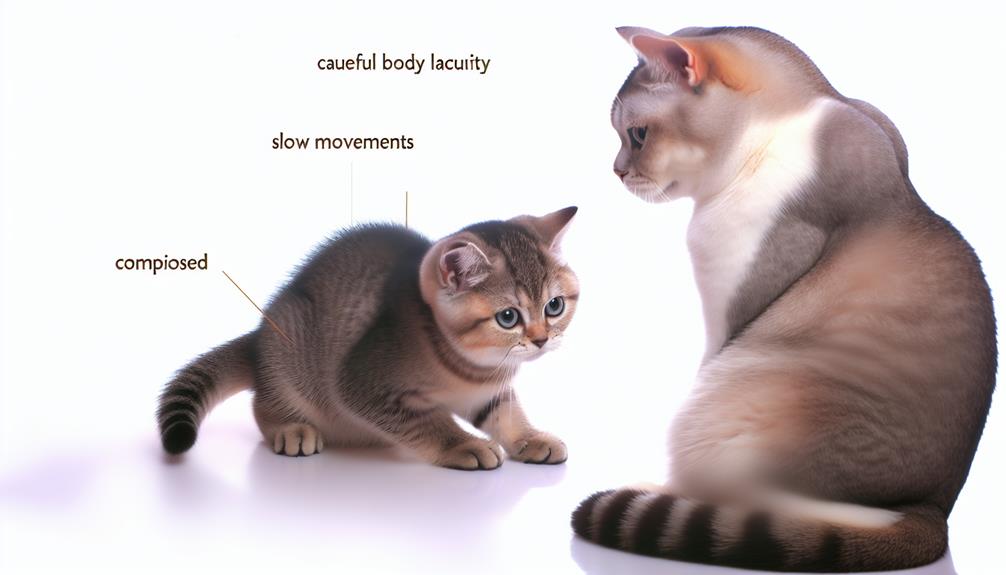
To understand your cat's behavior when introducing a new kitten, observe how your cat reacts to change in its environment. Cats communicate through body language, vocalizations, and scent marking. When a new kitten is introduced, pay attention to any hissing, growling, or tail puffing from your cat, as these are signs of discomfort or territorial behavior. Understanding feline communication is crucial in deciphering how your cat feels about the new addition.
Cats are known for their intricate social hierarchy within a household. When a new kitten enters the picture, it can disrupt the established order, causing stress and tension among the feline residents. Your cat might assert dominance or feel threatened by the newcomer, leading to various behaviors such as avoidance, aggression, or excessive grooming. By recognizing the importance of social hierarchy in cats, you can better anticipate and manage any conflicts that may arise during the introduction process. Paying attention to your cat's body language and vocal cues will provide valuable insight into how they're adjusting to the new kitten.
Preparation of Safe Space
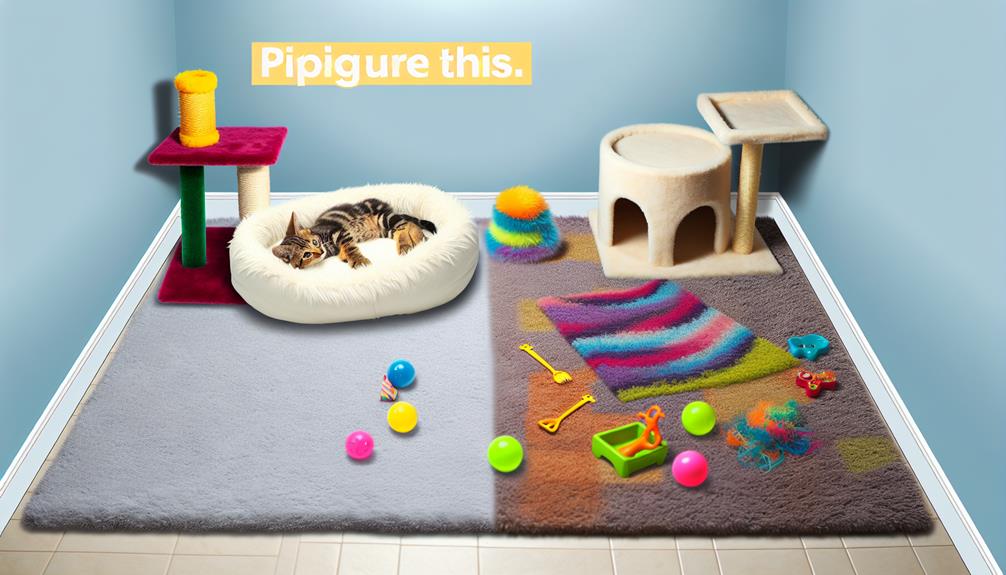
When preparing a safe space for your new kitten and cat introduction, ensure you set up a designated area that's secure and comfortable.
Creating a cat-friendly environment will help ease the transition and reduce stress for both feline friends.
Remember to introduce the kitten and cat slowly to avoid overwhelming them during the initial stages.
Safe Space Setup
Create a designated safe area for your new kitten before introducing them to your existing cat. Observing their behavior in this space can give you insights into their comfort levels. When setting up the safe space, consider the design to ensure it's a secure and stress-free environment for the kitten.
Here are three key elements to include in the safe space setup:
- Provide hiding spots like cardboard boxes or cat trees for the kitten to feel secure.
- Include a cozy bed or blanket where the kitten can rest comfortably.
- Place food, water, and a litter box in separate areas to encourage healthy habits.
Cat-Friendly Environment
As you prepare the space for your new kitten to acclimate, ensure it's set up to be welcoming and comfortable for both your new addition and your existing cat.
Understanding cat behavior is crucial when creating a cat-friendly environment. Cats appreciate vertical space, so provide cat trees or shelves for climbing. Consider safe space arrangement by having separate food and water stations to prevent territorial issues.
Offer multiple hiding spots, like cozy beds or boxes, for both cats to retreat to. Use pheromone diffusers to help reduce stress and promote relaxation. Keep the litter boxes clean and in quiet areas.
Slow Introduction Process
To ensure a smooth transition for your new kitten and existing cat, gradually introduce them by preparing a safe space conducive to their initial interactions. Creating a positive environment is crucial for successful introductions. Here are some key steps to follow:
- Provide separate living areas: Initially, keep the kitten and cat in separate spaces to prevent stress.
- Exchange scents: Swap bedding or toys between the kitten and cat to help them get used to each other's scent.
- Supervise interactions: During supervised meetings, engage in bonding activities like play sessions to facilitate trust building between the two pets.
Scent Exchange
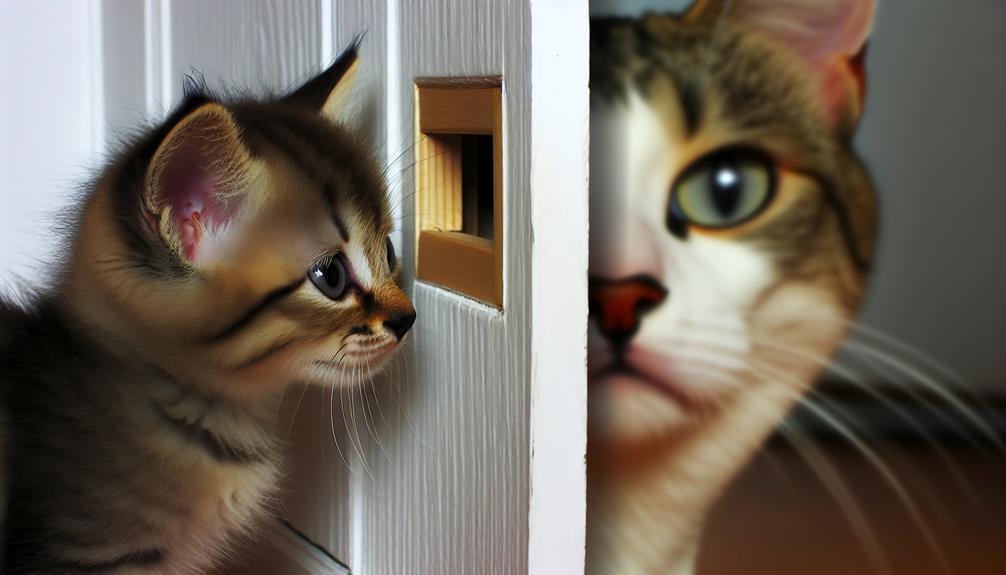
To help your kitten and cat get acquainted, start by understanding the importance of scent familiarity.
Gradually swap bedding or toys between the two to introduce each other's scents in a non-threatening way.
This process can help ease the transition and foster a sense of comfort between your pets.
Scent Familiarity Importance
Ensuring scent familiarity between your new kitten and existing cat is crucial for a successful introduction process. This step helps in scent recognition, aiding in the bonding process between your pets.
Here are three key points to consider:
- Comfort Zone: Maintaining a familiar scent around both the kitten and cat helps them feel secure in their environment.
- Acclimation: Exchanging bedding or toys between the two animals can assist in the acclimation process, making the introduction smoother.
- Bonding: Shared scents create a sense of unity and acceptance, fostering a positive relationship between your pets.
Gradual Scent Swapping
Swapping scents gradually between your kitten and cat can facilitate a smoother introduction process and help in their bonding. Start by swapping bedding or toys between them to introduce each other's scents.
This gradual scent introduction allows the animals to become familiar with each other's presence without direct contact. During this slow acclimation, observe their behavior closely. Look for signs of curiosity, relaxation, or stress.
If either pet shows signs of aggression or fear, separate them and continue the scent exchange at a slower pace. By monitoring their behavior during scent swapping, you can gauge their readiness to move on to the next step of introduction, ensuring a more harmonious relationship between your kitten and cat.
Visual Introduction
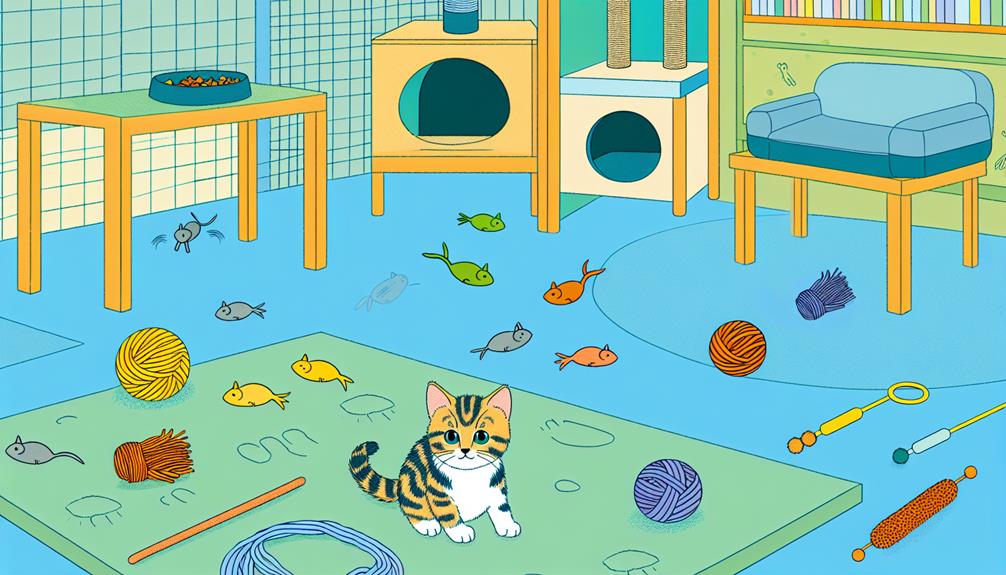
When introducing your kitten to your cat visually, allow them to observe each other from a safe distance. This initial visual introduction sets the stage for their future interactions.
Here are some key points to consider when visually introducing your kitten to your cat:
- Playful Introductions: Encourage interactive play sessions separately with both your kitten and cat to help them associate positive experiences with each other's scents.
- Bonding Activities: Engage in bonding activities such as grooming or feeding time where both animals can be near each other without direct contact.
- Visual Cues, Body Language Interpretation: Pay attention to their body language during the visual introduction. Look for signs of curiosity, tension, or aggression to gauge their comfort levels.
Controlled Interaction
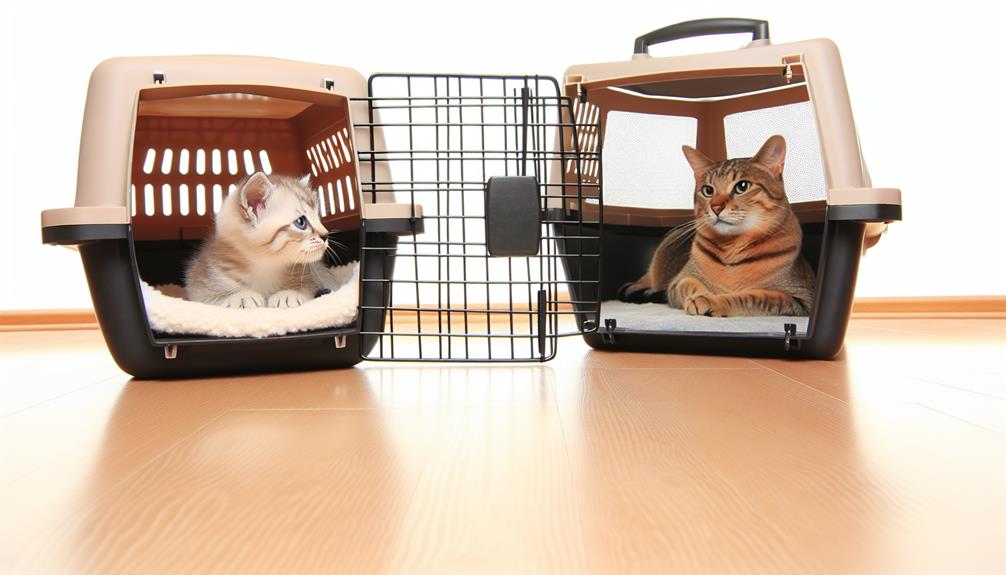
To facilitate a smooth transition from visual introduction to controlled interaction between your kitten and cat, consider setting up controlled environments for their initial face-to-face encounters.
Playtime supervision is crucial during these interactions to ensure both your kitten and cat are safe. Start with gradual introductions, allowing them to get used to each other's presence without feeling overwhelmed. While they interact, monitor their body language closely. Signs of aggression such as hissing, growling, or raised fur should be addressed immediately.
If aggression occurs, separate them calmly and give each pet some space. Handling aggression appropriately is key to preventing negative associations between the two animals. Remember, these controlled interactions are meant to be positive experiences for both your kitten and cat.
Feeding Time Strategy

When introducing your kitten to your cat, it's essential to consider a feeding time strategy. Gradually transitioning their meals and providing separate feeding locations can help reduce tension and promote harmony between the two pets.
Mealtime Gradual Transition
During the introduction phase between your kitten and cat, consider implementing a gradual transition strategy for mealtime to facilitate a smoother adjustment period. When introducing your kitten to your cat's meal routine, remember:
- Slow Integration: Allow your kitten to observe mealtime interactions from a distance before directly participating.
- Mealtime Etiquette: Teach both pets to wait patiently for their food without disturbing each other.
- Supervised Meals: Initially, supervise mealtime to ensure both pets are comfortable and there are no conflicts over food.
Separate Feeding Locations
Consider designating separate feeding locations for your kitten and cat to establish a harmonious feeding routine. This strategy helps prevent food aggression, where one feline may feel threatened by the other while eating.
By allowing each pet to eat in peace, you can reduce the likelihood of conflicts during mealtime. Additionally, having separate feeding areas helps in avoiding territory marking. Cats can be territorial creatures, and sharing a food bowl might trigger them to mark their territory, leading to potential tension between your kitten and cat.
Ensuring that each pet has its designated feeding spot can promote a calm and stress-free dining experience for both animals, fostering a positive environment for their interactions.
Playtime Supervision
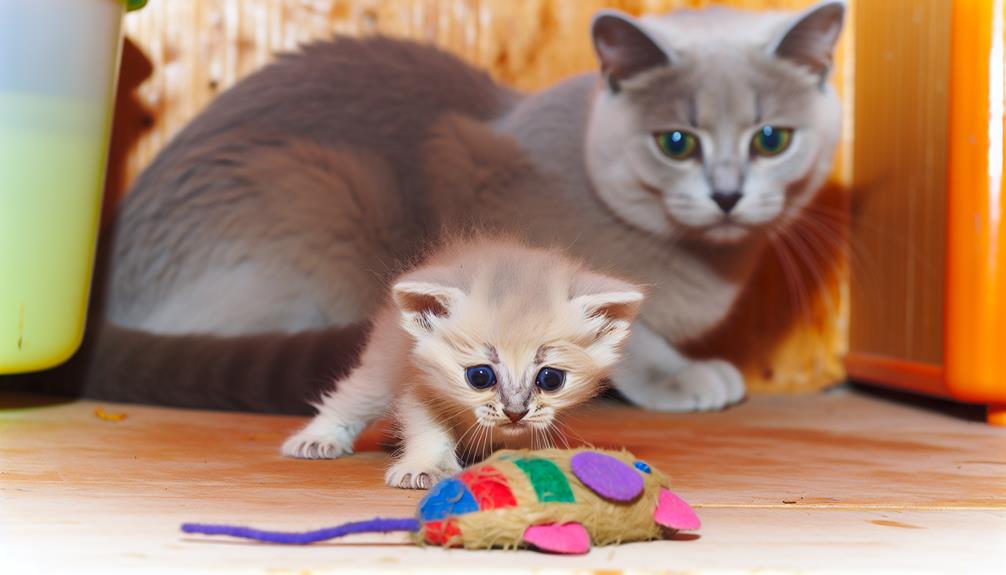
To ensure a positive interaction between your kitten and cat during playtime, always supervise their interactions closely. Here are some essential tips for successful playtime supervision:
- Start Slow: Begin with short supervised play sessions to allow your kitten and cat to get used to each other's presence.
- Use Interactive Toys: Engage both pets with interactive toys like feather wands or laser pointers to encourage positive interactions and bonding.
- Provide Safe Spaces: Ensure each pet has a safe space to retreat to if they feel overwhelmed, helping to prevent any potential conflicts.
Monitoring Body Language

Pay attention to your kitten and cat's body language cues to understand how they're feeling during playtime. Body language cues play a crucial role in the socialization process between your pets. When monitoring their interactions, observe their behavior closely. Positive signs include relaxed postures, gentle play, and mutual grooming. On the other hand, signs of tension may include flattened ears, hissing, growling, raised fur, or swatting. These cues can help you gauge the level of comfort and acceptance between your kitten and cat.
Proper behavior observation is key in ensuring a successful introduction between your pets. Use these body language signals to adjust your introduction techniques accordingly. If you notice any signs of stress or aggression, it might be necessary to slow down the introduction process. By closely monitoring their interactions and responding to their cues, you can create a safe and harmonious environment for your kitten and cat to gradually build a positive relationship.
Gradual Introductions
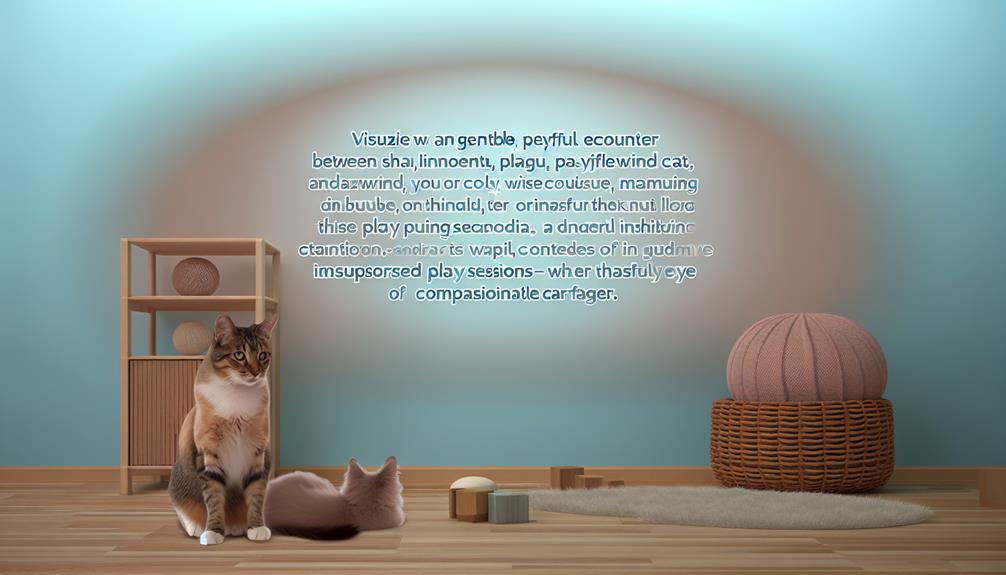
As you progress with the introduction process between your kitten and cat, take gradual steps to allow them to acclimate to each other's presence. Understanding feline behavior is crucial during this phase. Here are some key points to consider:
- Slow introduction process: Introduce your kitten and cat slowly to prevent overwhelming either of them. Start by swapping their bedding or toys to familiarize them with each other's scents.
- Gradual acclimation: Allow your pets to see and smell each other through a cracked door or a baby gate. This way, they can investigate safely without direct contact, helping them get used to each other's presence.
- Patience and observation: Be patient throughout the process. Watch their body language closely for signs of stress, aggression, or curiosity. Adjust the introduction pace based on how they react to each other.
Providing Individual Attention
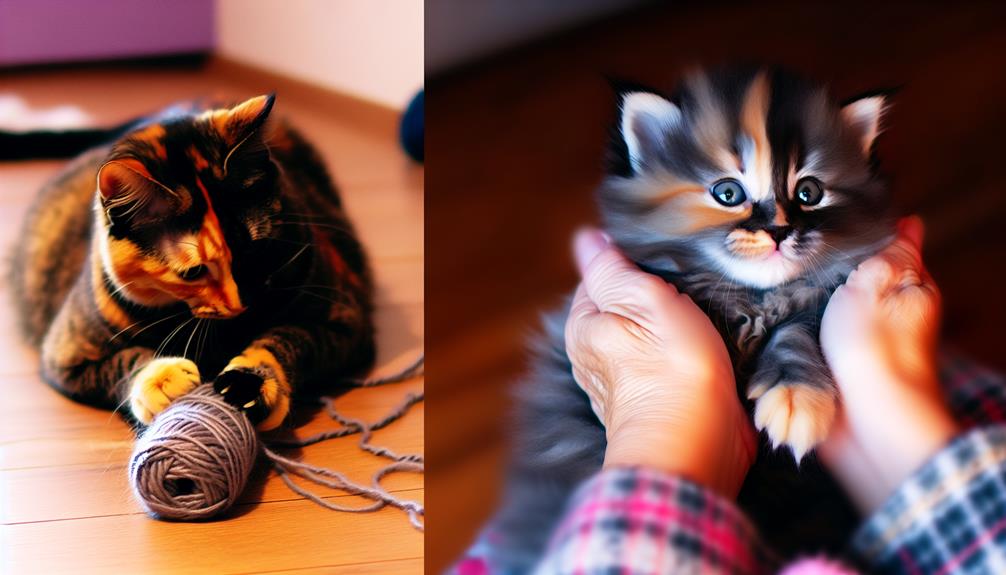
When introducing your kitten to your cat, make sure to:
- Allocate time for individual play sessions.
- Set up separate feeding areas.
- Include personalized cuddle time for each pet.
This focused attention will help them feel valued and lessen potential conflicts as they adjust to each other's presence in the household.
Prioritizing these interactions can create a smoother transition and foster a positive relationship between your kitten and cat.
Individual Play Sessions
To provide individual attention during individual play sessions, focus on engaging with one pet at a time. Here are some tips for making the most out of these individual play sessions:
- Interactive Toys: Use toys that encourage interactive play between you and your pet, such as feather wands or laser pointers.
- Playtime Routine: Establish a consistent playtime routine for each pet to ensure they receive equal attention and stimulation.
- Rotate Toys: Rotate the toys used during play sessions to keep your pets engaged and prevent boredom.
Separate Feeding Areas
Paying attention to individual pets' need for space and comfort, setting up separate feeding areas can help ensure each pet receives the necessary care and attention.
By providing distinct feeding spots for your kitten and cat, you can prevent potential food aggression issues that may arise when they eat together. Cats are territorial animals, and having separate feeding areas helps address any territory issues that could lead to conflicts during meal times.
This setup allows each pet to enjoy their food peacefully without feeling threatened or rushed. It also promotes a sense of security and control over their own space, reducing stress and promoting a harmonious cohabitation between your kitten and cat.
Personalized Cuddle Time
For a harmonious bond between your kitten and cat, setting aside personalized cuddle time is essential. This one-on-one interaction helps build trust and friendship between your pets.
To make the most of this time, consider the following:
- Bonding activities: Engage in interactive play sessions with both your kitten and cat to encourage positive associations.
- Socialization techniques: Gradually introduce your pets to each other's scents during cuddle time to help them become familiar with one another.
- Rotate attention: Ensure each pet receives equal individual attention to prevent jealousy and promote a balanced relationship.
Respect Personal Space
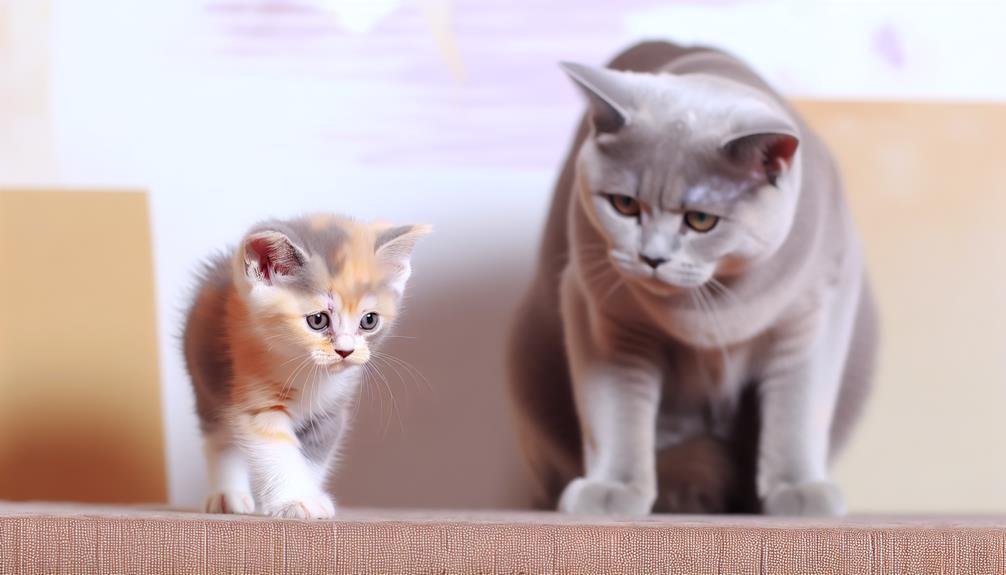
Always remember to give your cat space to feel comfortable when introducing a new kitten. Setting boundaries is crucial during this period. Ensure your cat has designated areas where they can retreat to if they feel overwhelmed. Implement socialization techniques slowly, allowing both your cat and kitten to adjust at their own pace. Respect your cat's personal boundaries by not forcing interactions.
Supervise playtime closely to prevent any rough behavior. Cats communicate through body language, so pay attention to their cues. If your cat shows signs of stress or aggression, separate them from the kitten and give them some time alone. Providing vertical spaces like cat trees or shelves can also help your cat feel secure.
Remember that each cat is different, and some may need more time to adapt to a new kitten. By respecting your cat's personal space and boundaries, you create a safe environment for both your cat and the new addition to the family.
Encourage Positive Encounters
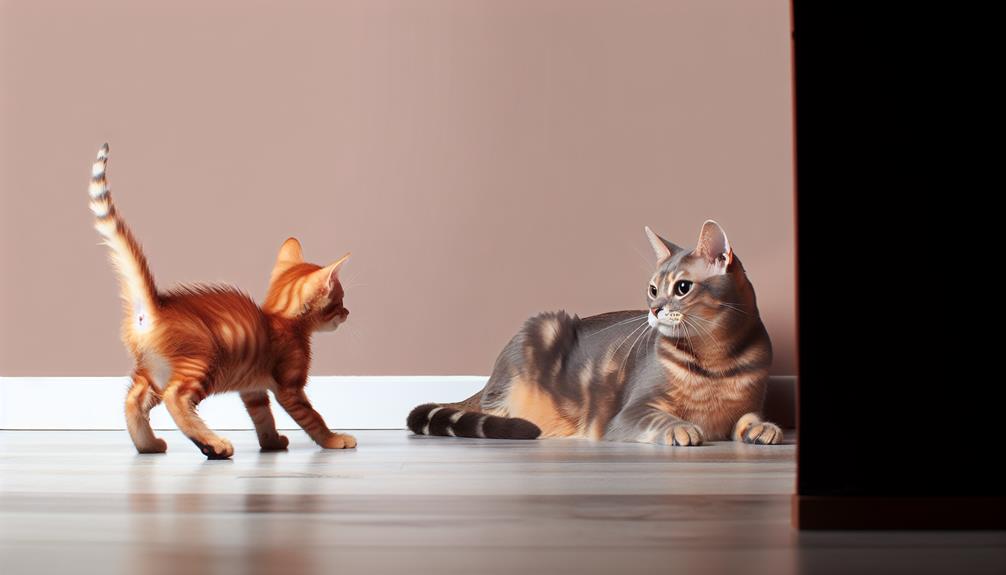
Encouraging positive encounters between your cat and the new kitten is key to fostering a harmonious relationship in your household. To ensure a smooth introduction, consider the following:
- Positive Reinforcement: Use treats, toys, and affection to reward good behavior during interactions. This will help both your cat and kitten associate these encounters with positive experiences.
- Behavior Modification: If either the cat or kitten displays unwanted behavior during their interactions, such as hissing or swatting, consider behavior modification techniques. Redirect their attention to a toy or treat to encourage more positive interactions.
- Supervised Playtime: Monitor their interactions closely, especially during the initial introductions. Step in if things get too rough or if either pet seems stressed. Gradually increase the duration of their playtime as they become more comfortable with each other.
Time and Patience

When introducing a new kitten to your cat, remember that building a strong relationship takes time and patience. Your existing cat might need time to adjust to the new addition, and your kitten will also need time to feel comfortable in its new environment.
Use positive reinforcement to encourage good behavior from both your cat and kitten. Reward them with treats or praise when they interact calmly or positively.
Bonding activities, such as interactive play sessions with toys or grooming sessions where both animals can be involved, can help them get accustomed to each other's presence. Be patient and allow them to explore each other at their own pace.
Avoid rushing the introduction process; let them establish their boundaries naturally. With time and patience, your cat and kitten will likely form a strong bond that will enrich both of their lives.
Handling Aggression
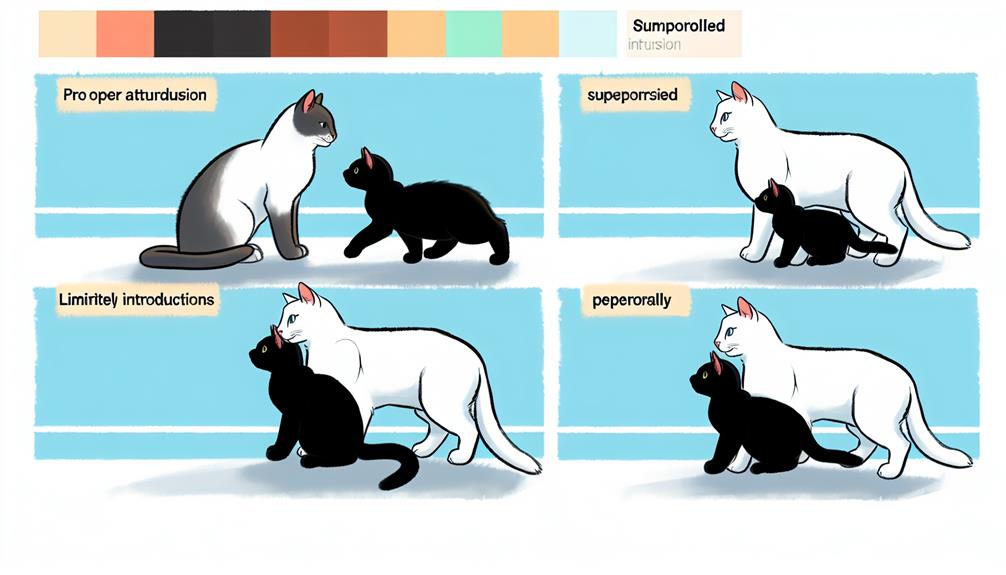
Dealing with aggression between your cat and new kitten requires understanding their body language and intervening calmly to prevent escalating tensions. When managing aggression, behavior modification techniques can be highly effective in fostering a peaceful coexistence:
- Positive Reinforcement: Encourage desirable behaviors such as playing together peacefully by rewarding them with treats or praise.
- Environmental Enrichment: Provide separate spaces for each pet to retreat to when feeling overwhelmed, reducing the likelihood of conflicts.
- Supervised Interactions: Monitor their interactions closely and step in if you notice signs of aggression, redirecting their focus onto positive activities.
Seeking Professional Help

Seek professional help if you're struggling to manage the aggression between your cat and new kitten. Sometimes, despite your best efforts, the situation may become too overwhelming for you to handle alone. In such cases, a behavior expert can provide valuable insights and guidance to help ease the tension between your pets.
A behavior expert specialized in feline behavior can assess the dynamics between your cat and kitten, offering tailored solutions to address the aggression and facilitate a smoother introduction process. Professional consultation allows for a more in-depth understanding of the underlying causes of aggression and the most effective ways to address it.
Frequently Asked Questions
How Can I Prevent My Cat From Feeling Neglected After Introducing a Kitten?
To prevent your cat from feeling neglected after introducing a kitten, balance attention by engaging in bonding activities like playtime together. Provide separate spaces for alone time and ensure both pets receive equal love and affection.
What Should I Do if My Cat and Kitten Refuse to Interact at All?
If your cat and kitten refuse to interact, observe their behavioral cues. Slowly introduce them, focusing on kitten socialization and cat integration. Provide separate safe spaces, gradually allowing supervised interactions. Be patient, and seek advice from a veterinarian if needed.
Is It Normal for My Cat to Show Signs of Jealousy Towards the Kitten?
Feeling jealousy signs from your cat towards the kitten is common. Understand your cat's behavior and reactions. Managing jealousy can involve giving attention, separate resting areas, and positive reinforcement. Gradually, they may adjust and coexist peacefully.
Can I Leave My Cat and Kitten Alone Together Unsupervised?
You should never leave your cat and kitten alone together unsupervised. It's important to oversee their interactions closely to ensure their safety and wellbeing. Start with gradual introductions and always be there to monitor.
How Do I Know When It's Safe to Allow My Cat and Kitten to Roam Freely Together?
When it's safe for your cat and kitten to freely roam together depends on their interactions during supervised bonding time and playtime. Watch their body language closely for signs of comfort and playfulness before allowing unsupervised access.
Conclusion
In conclusion, introducing a new kitten to your resident cat requires patience, understanding, and careful planning. By following the steps outlined in this article, such as creating a safe space, exchanging scents, and gradually introducing the two cats, you can help them build a positive relationship over time.
Remember to monitor their interactions, provide separate feeding areas, and seek professional help if needed to ensure a successful integration. With time and patience, your kitten and cat can become lifelong companions.







